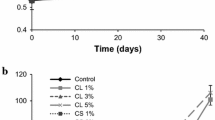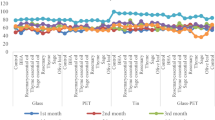Abstract
The chemical characteristics, phenolic content and antioxidant activity of olive oils flavored with garlic, lemon, oregano, hot pepper, and rosemary were evaluated during 9 months of storage. At the end of the storage period, the unflavored and the garlic-flavored oils maintained their chemical parameters within the limits fixed for extra-virgin olive oils. After 9 months of storage, a noticeable decrease in phenolic content was observed in all the oils. The highest (35.0 ± 3.9 mg/kg oil) and the lowest (6.3 ± 0.4 mg/kg) phenolic contents were detected in the unflavored and garlic-flavored oils, respectively. Compounds such as 3,4-DHPEA-EDA (3,4-dihydroxyphenylethyl 4-formyl-3-formylmethyl-4-hexenoate, the dialdehydic form of decarboxymethyl elenolic acid linked to hydroxytyrosol) and p-HPEA-EDA (dialdehydic form of the decarboxymethyl elenolic acid linked to tyrosol) were the most abundant in both unflavored and lemon-flavored oils up till 6 months of storage. At the end of the storage period, increases in 3,4-DHPEA (hydroxytyrosol) and p-HPEA (tyrosol) were measured in almost all the oils. During storage, the antioxidant activity coefficients of the phenolic extracts, calculated according to the β-carotene bleaching assay, significantly decreased and, after 9 months, were in a decreasing order: rosemary (51.3 ± 4.2), hot pepper, lemon, oregano, unflavored, and garlic (8.5 ± 0.7).



Similar content being viewed by others
References
Jacotot B (1994) Olive oil: a food and medicine in one. Olivae 54:40–41
Visioli F, Bogani P, Grande S, Galli C (2004) Olive oil and oxidative stress. Grasas y Aceites 55:66–75
Moldão-Martins M, Beirão-Da-Costa S, Neves C, Cavaleiro C, Salgueiro L, Beirão-Da-Costa ML (2004) Olive oil flavored by the essential oils of Mentha x piperita and Thymus mastichina L. Food Qual Prefer 15:447–452
Tsimidou M, Boskou D (1994) Antioxidant activity of essential oils from the plants of the Lamiaceae family. In: Charalambous G (ed) Spices, herbs and edible fungi. Elsevier, Amsterdam, pp 273–284
Loo A, Richard H (1992) Origine et propriétés des épices et des aromates bruts. In: Richard H (ed) Épices et Aromates. TEC & DOC, Paris, pp 18–22
Offord EA, Guillot F, Aeschbach R, Löliger J, Pfeifer AMA (1997) Antioxidant and biological properties of rosemary components: implication for food and health. In: Shahidi F (ed) Natural antioxidants: chemistry, health effects and applications. AOCS Press, Champaign, pp 88–91
Halliwell B, Aeschbach R, Loliger J, Aruoma OI (1995) The characterization of antioxidants. Food Chem Toxicol 33:601–617
Middleton E, Kandaswami C, Theoharides TC (2000) The effects of plant flavonoids on mammalian cells: implications for inflammation, heart disease and cancer. Pharmacol Rev 52:673–839
Marinova EM, Yanishlieva NV (1997) Antioxidative activity of extracts from selected species of the family Lamiaceae in sunflower oil. Food Chem 58:245–248
Karpinska M, Borowski J, Danowska-Oziewicz M (2001) The use of natural antioxidants in ready-to-serve food. Food Chem 72:5–9
Benzie IFF (1996) Lipid peroxidation: a review of causes, consequences, measurement and dietary influences. Int J Food Sci Nutr 47:233–261
Damechki M, Sotiropoulou S, Tsimidou M (2001) Antioxidant and pro-oxidant factors in oregano and rosemary gourmet olive oils. Grasas y Aceites 52:207–213
Tsimidou M (1998) Polyphenols and quality of virgin olive oil in retrospect. Ital J Food Sci 10:99–116
Baiano A, Gomes T, Severini C (2005) Effects of herbs on hydrolytic and oxidation degradation of olive oil in canned tomatoes. J Am Oil Chem Soc 82:759–765
Antoun N, Tsimidou M (1998) Olive oil herb and spice specialities: preconceived ideas of potential consumers about their nutritional and sensorial attributes. Olivae 71:56–62
Official Methods and Recommended Practices of the American Oil Chemists’ Society (2003) Methods Cd 3d-63, Cd 8b-90, and Ch 5-91, 5th edn. AOCS Press, Champaign
Gambacorta G, Faccia M, Pati S, Lamacchia C, Baiano A, La Notte E (2007) Changes in the chemical and sensorial profile of extra virgin olive oils flavored with herbs and spices during storage. J Food Lipids 14:202–215
Montedoro G, Servili M, Baldioli M (1992) Simple and hydrolyzable phenolic compounds in virgin olive oil. I. Their extraction, separation, and quantitative and semiquantitative evaluation by HPLC. J Agric Food Chem 40:1571–1576
Di Stefano R, Mc Cravero, Genilizzi N (1989) Metodi per lo studio dei polifenoli nei vini. L’Enotecnico 5:83–89
Gambacorta G, Previtali MA, Pati S, Baiano A, La Notte E (2006) Characterization of the phenolic profiles of some monovarietal extra virgin olive oils of Southern Italy. XXIII International conference on polyphenols. Winnipeg, Manitoba, Canada, 22–25 August 2006
Brenes M, García A, García P, Garrido A (2000) Rapid and complete extraction of phenols from olive oil and determination by means of a coulometric electrode array system. J Agric Food Chem 48:5178–5183
Gómez-Alonso S, Salvador MD, Fregapane G (2002) Phenolic compounds profile of Cornicabra virgin olive oil. J Agric Food Chem 50:6812–6817
Morello JR, Motiva MJ, Tovar MJ, Romero MP (2004) Changes in commercial virgin olive oil (cv. Arbequina) during storage, with special emphasis on the phenolic fraction. Food Chem 85:357–364
Gómez-Alonso S, Mancebo-Campos V, Salvador MD, Fregapane G (2007) Evolution of major and minor components and oxidation indices of virgin olive oil during 21 months storage at room temperature. Food Chem 100:36–42
Gómez-Rico A, Fregapane G, Salvador MD (2008) Effect of cultivar and ripening on minor components in Spanish olive fruits and their corresponding virgin olive oils. Food Res Intern 41:433–440
Escarpa A, Morales MD, González MC (2002) Analytical performance of commercially available and unavailable phenolic compounds using real samples by high-performance liquid chromatography-diode-array detection. Anal Chim Acta 460:61–72
Obied HK, Bedgood DR Jr, Prenzler PD, Robards K (2007) Bioscreening of Australian olive mill waste extracts: biophenol content, antioxidant, antimicrobial and molluscicidal activities. Food Chem Toxicol 45:1238–1248
EC (2003) Commission Regulation 1989/2003 amending Regulation (EEC) No 2568/91 on the characteristics of olive oil and olive–pomace oil and on the relevant methods of analysis. Off J Eur Union L295:57–77
Negishi O, Negishi Y, Ozawa T (2002) Effects of food materials on removal of allium-specific volatile sulfur compounds. J Agric Food Chem 50:3856–3861
McManus JP, Davis KG, Beart JE, Gaffney SH, Lilley TH, Haslam E (1985) Polyphenol interactions. Part 1. Introduction: some observations on the reversible complexation of polyphenols with proteins and polysaccharides. J Chem Soc (Perkin Trans 2) 99:1429–1438
Mole S, Waterman PG (1985) Stimulatory effects of tannins and cholic acid on tryptic hydrolysis of proteins: ecological implications. J Chem Ecol 11:1323–1332
Prasad K, Laxdal VA, Yu M, Raney BL (1995) Antioxidant activity of allicin, an active principle in garlic. Mol Cell Biochem 148:183–189
Baiano A, Gambacorta G, Terracone C, Previtali MA, Lamacchia C, La Notte E (2009) Changes in phenolic content and antioxidant activity of Italian extra-virgin olive oils during storage. J Food Sci 74:177–183
Gorinstein S, Martin-Belloso O, Katrich E, Lojek A, Čiž M, Gligelmo-Miguel N, Haruenkit R, Park YS, Jung ST, Trakhtenberg S (2003) Comparison of the contents of the main biochemical compounds and the antioxidant activity of some Spanish olive oils as determined by four different radical scavenging tests. J Nutr Biochem 14:154–159
Rice-Evans CA, Miller NJ, Paganga G (1996) Structure antioxidant activity relationship of flavonoids and phenolic acids. Free Radic Biol Med 20:933–956
Hernández-Hernández E, Ponce-Alquicira E, Jaramillo-Flores ME, Guerrero Legarreta I (2009) Antioxidant effect of rosemary (Rosmarinus officinalis L.) and oregano (Origanum vulgare L.) extracts on TBARS and colour of model raw pork batters. Meat Sci 81:410–417
Author information
Authors and Affiliations
Corresponding author
About this article
Cite this article
Baiano, A., Terracone, C., Gambacorta, G. et al. Changes in Quality Indices, Phenolic Content and Antioxidant Activity of Flavored Olive Oils during Storage. J Am Oil Chem Soc 86, 1083–1092 (2009). https://doi.org/10.1007/s11746-009-1446-8
Received:
Revised:
Accepted:
Published:
Issue Date:
DOI: https://doi.org/10.1007/s11746-009-1446-8




